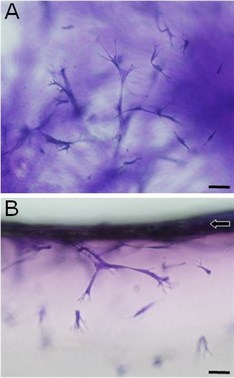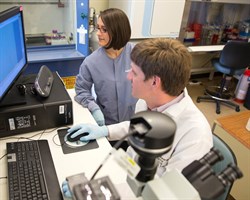Ongoing basic science projects include:
- Optimization of canine mesenchymal stem cell (MSC) osteogenic (bone) differentiation
- Use of serum-free three-dimensional (3D) collagen scaffolds to enhance MSC chondrogenic (cartilage) differentiation
- Assessment of matrix metalloproteinase (MMP) invasion of MSCs in response to wound environments
- Collaborative efforts to develop tissue engineering devices for bone and cartilage repair
Invasion of canine Multipotent Stromal Cells (MSCs) in three-dimensional (3D) collagen invasion assay
Identifying MSCs with superior homing and invasion abilities may serve as a useful in vitro assay when screening MSCs for clinical use. In addition, these assays allow stem cell biologists to study the molecular mechanisms involved in this process. Panel A: MSCs are seeded on the surface of a 3D collagen gel (blue background, out of focus). In response to certain growth-factors, MSCs invade the gel employing integrins, MMPs, cytoskeletal reorganization, and cell signaling in the process (bar = 50μm). Panel B: The gel from Panel A is sectioned and examined from a side-view. Open arrow denotes starting monolayer of MSCs. Invading MSCs are more clearly visible within the gel using this view (bar = 50μm).

Microscopic evaluation of canine Multipotent Stromal Cells (MSCs)
Robert Bearden (graduate student) and Shelby Gasson (veterinary summer research student) evaluate a culture of canine MSCs using phase contrast microscopy and digital photography.

